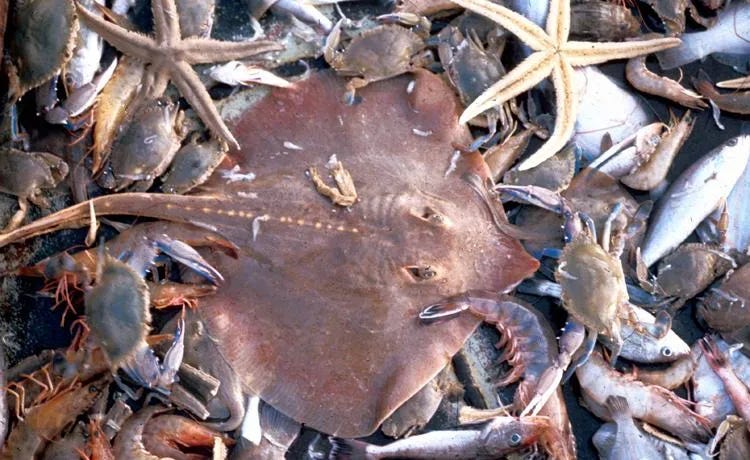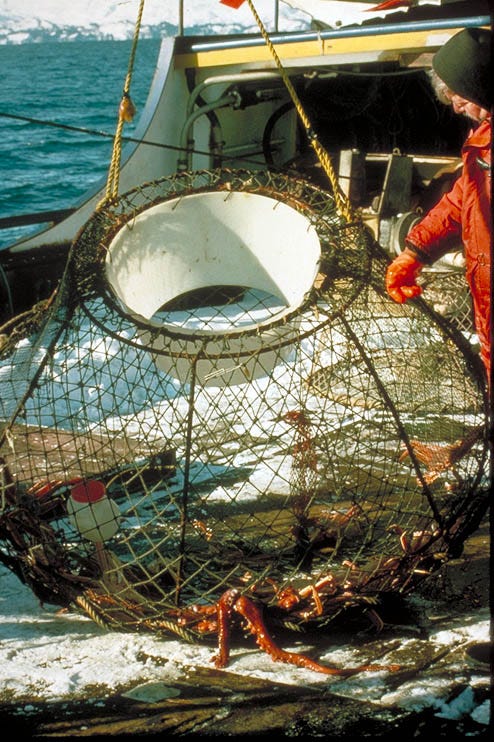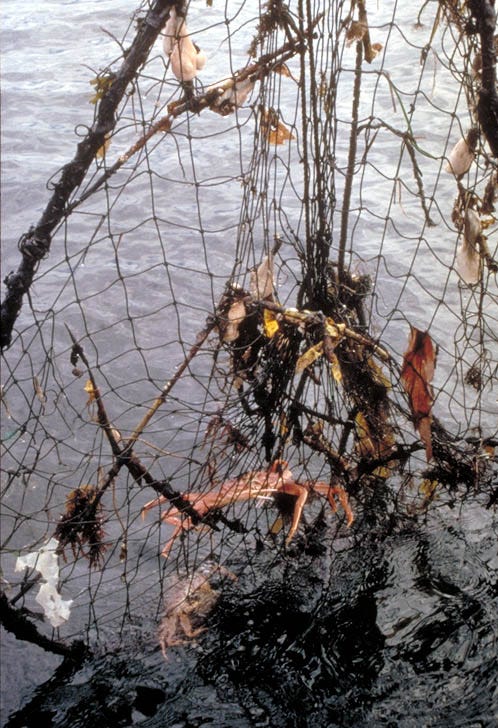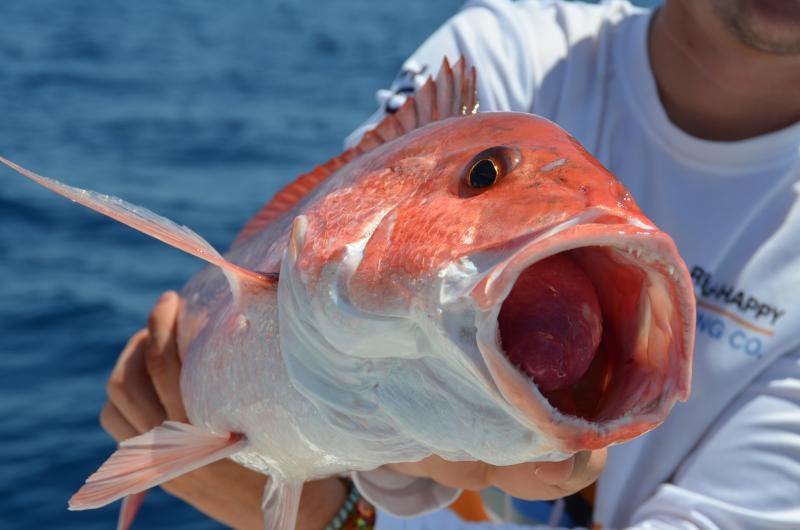Sustainable Seafood 11. Bycatch and Discard Mortality
In which the E@L laments the loss of sealife due to destructive fishing methods
If you’ve ever seen a clearcut forest, your first reaction might be disgust. How can we humans be so destructive? Removing all the trees from hillsides exposes them to erosion, which fills streams and waterways with sediment, harming fish, and warming the water, reducing oxygen availability. It deprives forest animals of the shelter and food that they need. And unless reseeded, clearcuts may not recover for decades.
Fishing also has environmental impacts. Trawling, for example, is one of the most common methods of catching fish. Trawls are large nets that may be as wide and long as a football field. Bottom trawls are fished on or near the seafloor, whereas pelagic or mid-water trawls are supposed to be fished off-bottom (but some do contact the seafloor inadvertently). Trawls are used to catch bottomfish such as flounder, cod, and hake/whiting, as well as shrimp. Dragging trawl nets across the seafloor creates impacts similar to clearcutting a forest. As I described in “The Trouble with Traps” trawls can remove benthic organisms such as sponges, corals, sea stars, and other emergent epifauna, many of which create habitat for other organisms such as juvenile fish, crabs, and scallops. This process was described in even greater detail by Jason Anthony in his post “Scraping Bottom”. Rather than retell that story, this post will focus on other impacts caused by fishing, collectively known as bycatch and discard mortality.
You Can’t Always Catch What You Want
Bycatch is defined as the catch of unwanted, juvenile, or non-target fish or other species. Bycatch may include fish, birds, mammals, crustaceans, and turtles. Bycatch may also be created when fishing gear damages or kills organisms that are not observed. In 2009, total marine fishery bycatch was estimated to be 38.5 million tons, representing 40.4% of the total catch of 95.2 million tons. Trawls are notorious for catching unwanted species such as turtles, marine mammals or birds, which may drown in the net. Most shrimp fisheries catch much less shrimp than bycatch, which may constitute 80 to 95% of the catch. Once captured, unwanted organisms must be returned to the water, but may not survive, leading to discard mortality.
Bycatch is not only an ecological waste but may count against another type of fishing quota. For example, salmon or halibut caught in Alaskan trawl fisheries must be subtracted from the quotas allocated to the salmon and halibut fleets, even if they are killed or thrown back. Just recently (Sept 27, 2024) the Gulf of Alaska pollock fishery was closed due to an unprecedented bycatch of 2000 Chinook salmon, which caused the fleet to exceed the total bycatch cap of 18,000 salmon, but left 50,000 tons (over 1 Million lbs) of the pollock quota uncaught. This was a major economic setback for the port of Kodiak, Alaska (where I worked for 22 years), due to the loss of product and income from the pollock fishery.

All gear types, including trawls, longlines, and traps produce bycatch, some more than others. Bycatch is problematic for many reasons. It is a waste of resources; it costs time and money to sort it out of the catch, and it may damage fishing gear. NOAA has a Bycatch Reduction Strategy to help develop fishing methods and policies that minimize bycatch. These may include gear modifications, fishery/area closures, and by placing observers on fishing vessels to monitor bycatch. Unfortunately, it is very difficult to estimate bycatch. It requires placing observers aboard fishing vessels, which is expensive, and requires specialized training. (Your E@L started his career as a Fishery Observer aboard Russian fishing vessels, but that’s another story). Although required in many fisheries, observer coverage rarely exceeds a few percent of the fishing fleet or fishing effort. This is especially true in developing countries which have many remote fishing ports with small artisanal fishing boats. Much of the published research on bycatch focuses on specific bycatch species, such as crabs, tuna, turtles, birds, sharks, etc., rather than on total bycatch in specific fisheries. For example, there are many published studies on bycatch of salmon in other fisheries, but virtually no studies on non-salmon bycatch in salmon fisheries.
Bycatch is for the Birds (and fish, crabs, and turtles)
Longlines are exactly what they sound like – fishing lines that may extend for miles near the sea surface (Pelagic) or on the seafloor. Thousands of baited hooks are attached at intervals, and used to catch tuna, sharks, and swordfish. Total bycatch of seabirds in longline fishing gear was estimated at 160,000 to 3.2 million birds/year, including albatrosses, penguins, petrels, shearwaters, and other seabirds. Demersal (near bottom) longlines are used to catch halibut, sablefish (aka blackcod), and tilefish. For a good explanation of longlining read Sebastian Junger’s “The Perfect Storm” or “The Hungry Ocean” by Linda Greenlaw. Longlines also produce lots of bycatch, including birds, turtles, and other fish.
Drifting gillnets, used to catch tuna, salmon, and other pelagic fish, also create large amounts of bycatch, estimated by Oceana to be 64% of the total catch. For this reason, they have been outlawed in the US EEZ, and banning them is the subject of international negotiation.
Purse Seines are used to catch schooling fish such as salmon, tuna, and sardines. The net is set by a seine skiff around a school of fish like hanging a curtain. The bottom margin is then “pursed” together which concentrates the fish into the center of the net. Fish may then be either pumped or brailed into the fishing boat. Because fish schools are usually comprised of a single species, purse seines have little bycatch or eco-impact. Large tuna seines may catch marine mammals, but widespread public condemnation in the 1970’s led to modern fishing methods that allow fishers to release them, thus “dolphin-safe” tuna. Bycatch in the European tuna purse-net fishery was estimated to be about 7.5% of the total catch in 2003-2007, of which 83% were non-target tuna.
The ratio of retained to discarded catch, called the Stock Utilization Efficiency (SUE), varies widely between fisheries. Fisheries with high retention rates and little bycatch include snow crab (0.98), sablefish (0.98), and Alaska pollock (0.92). In contrast, red king crab fisheries discarded 3 to 6 crabs for every crab kept in 1993, for a SUE of 0.24, and the SUE for Bering sea flounder trawl fisheries was 0.28 [1].
Estimates of discard mortality, the proportion of discarded catch that dies, are even harder to make. Fish are extremely sensitive to being caught, handled, and discarded, but mortality depends on many variables including species, type of gear used, on-deck exposure, methods and duration of the study, water temperature, and even weather conditions. Typically, mortality is assessed by retaining discarded fish in water-filled tanks, or placing them back into sea cages, neither of which mimic natural conditions. Generally, condition of fish caught by hook-and-line (e.g., salmon, tuna, halibut) is much better, and mortality lower, than fish caught in mobile gear such as trawls and seines (e.g., cod, flounder, herring), which are often crushed and suffocated before they can be recovered. Fish that are severely impaired may be preyed on by birds before they can submerge. Pelagic and demersal fish such as cod or salmon tend to have higher mortality than bottom dwelling fish such as flounder or halibut, which do not have a swim bladder. Mortality of black sea bass discarded from trap fisheries ranged from 14% in one study (where the gas bladder was vented) to 51% where no venting occurred.
Traps are used to catch many species, such as blue crabs, Dungeness crabs, king crabs and snow crabs, as well as lobsters, conchs/whelks, and black sea bass. The shape and placement of traps makes them very species-specific, and limits bycatch. The hard shells of crustaceans make them less susceptible than fish to damage during discarding. Although crabs can be damaged when removing them from the traps, loss of legs is not usually fatal. Mortality estimates for discarded crabs range from 5% for snow crabs from trap fisheries to 24% for trawl-caught Tanner crabs.
A bigger problem, however, is trap loss and derelict fishing gear (DFG). As detailed in “The Trouble with Traps”, such “Ghost traps” continue to catch and kill crabs, fish, turtles, otters, birds, etc, for long periods of time, and each dead animal becomes bait for others. This depletes crab and fish stocks and is a loss of income to the fishery. DFG may entangle or damage other fishing gear and may damage seafloor ecosystems when traps move as a result of storms or being dragged by boats.
In the Chesapeake Bay, blue crab fishers lose >50,000 traps/yr. At any one time there is a “standing stock” of about 150,000 lost traps, that catch 10-20 crabs/yr/trap, thus killing 1.5 to 3.0 million crabs annually. Densities of derelict crab traps can reach 2-5 traps per acre. In the Florida Keys, derelict lobster trap densities were 6.5 /acre, and constituted about 75% of anthropogenic debris. Derelict lobster traps can damage sponges and gorgonians. In Kodiak, Alaska, densities of derelict King/Tanner crab traps were about 1/acre [2]. Traps also create bycatch when they drag across the seafloor, or when their connecting lines damage seafloor organisms such as corals and sponges.


Whale Entanglement is one of the greatest problems caused by trap fishing. In New England, North Atlantic right whales (NARW) and humpback whales often get tangled in lobster trap buoy lines, and on the Pacific coast, gray whales become entangled in Dungeness crab traps. Over 85% of existing NARW have been entangled. Proposed solutions include using weak links between the traps and buoy lines, galvanic timed releases (GTRs, a piece of zinc that degrades after a specific time), and whale safe rope with breaking strength <1000 lbs. Lobster traps traditionally had one buoy per trap, but NOAA is promulgating regulations requiring traps to be fished on strings of multiple traps with only two buoys (one at each end of the string). Mapping of whale migration routes, and avoidance of overlap between traps and whales can reduce encounter rates. A promising development is ropeless fishing. This requires an electronic release mechanism (modem) that is triggered by an acoustic signal from the fishing vessel that causes the trap to release a buoy. Such systems can also provide information to other fishers or enforcement about the owner, license, and GPS drop position. In the future, additional sensors could measure depth, temperature, and even trap occupancy. Prototype systems have been developed by the Ropeless Consortium in cooperation with the Woods Hole Oceanographic Institute.
Even recreational fishing creates bycatch. When hooked fish are brought up from depths greater than 20 meters (about 66 feet), they suffer barotrauma; their gas bladder expands while ascending, causing the stomach to evert, which restricts blood flow and respiration. Other symptoms include bulging eyes (exophthalmia), sluggishness, and inability to submerge if discarded. Fish may die due to exposure to warm temperatures, inability to breathe, or predation. Mortality of fish discarded after capture by hook and line was 16.5% for Atlantic cod and 63% for haddock. Mitigation methods include reeling them up slowly, venting the gas bladder with a needle, or the use of descenders, which gently takes the fish back to the bottom and releases it.
You Are (more than) What You Eat
The next time you eat wild seafood, think about the fact that you are not just eating what is on your plate; each meal probably caused the death of some other organisms. Every pound of shrimp or flounder caught probably killed four pounds of other species; thus these fisheries create more bycatch than sellable seafood. On the other hand, seafoods such as tuna and salmon may have been caught with relatively little bycatch or impact to other species.
None of this should deter you from eating seafood, however. Seafood is still more nutritious than land-based meat products, contains less fat and calories, and more heart-healthy omega-3 fatty acids. It also produces only about 5 to 20% of the greenhouse gas emissions as beef production does. Nonetheless, consideration of bycatch impacts should be part of your decision process when you choose among seafood products.
As usual, Bon Appetit! Itadakimasu!
Writing about nature is not easy. It requires preparation, hard work, and sometimes sweat to observe nature, and time, thought, and effort to describe it. Although this post is free, becoming a paid subscriber will help me continue to share my thoughts, and encourage future postings.
This issue of Ecologist at Large is available to all readers. However, if you would like to support my work with a one-off contribution, click “Buy me a coffee” below.
Additional Sources
[1] Stevens, B. G. (2014). Impacts of fishing on king crabs: Bycatch, injuries, and mortality. Chapter 12 In B. Stevens (Ed.), King Crabs of the World: Biology and Fisheries Management. CRC Press (Taylor and Francis), Boca Raton, FL. https://doi.org/10.1201/b16664
[2] Stevens, B. G., Vining, I., Byersdorfer, S., & Donaldson, W. E. (2000). Ghost fishing by Tanner crab (Chionoecetes bairdi) pots off Kodiak, Alaska: pot density and catch per trap as determined from sidescan sonar and pot recovery data. Fishery Bulletin, 98, 389–399.






I loved this piece, thank you for writing it.
I was on a research cruise a few years ago that did a bottom trawl to measure biodiversity in a certain region, and the ratio of shrimp to other species was so disheartening. In fact, that trawl caught more octopus than shrimp.
And exciting news about the acoustic releases on traps! I've used those on bottom deployments that a line and buoy above would wreck the measurement.
I find your fact-based essays very enlightening and on-point. Having been in on "educational" trawls, I knew what an amazing range of creatures are caught. This has always bothered me about commercial trawling. Any effort to reduce the damage by trawling would seem to me to be worthwhile.